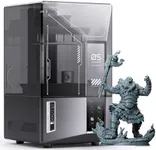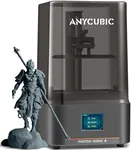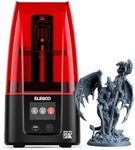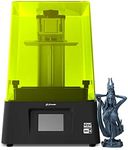Buying Guide for the Best Resin Printers
Choosing a resin printer can be exciting, especially if you want to create highly detailed models, miniatures, or prototypes. Resin printers use liquid resin and light to produce objects with fine details, making them popular for hobbyists, designers, and professionals. When picking the right resin printer, it's important to understand the key features that affect print quality, ease of use, and maintenance. By focusing on your needs—such as the size of objects you want to print, the level of detail you require, and how much time you want to spend on setup and cleaning—you can find a printer that fits your workflow and goals.Print ResolutionPrint resolution refers to how finely the printer can reproduce details, usually measured in microns (µm) for the layer height and XY resolution. Lower numbers mean higher detail. For example, a 35-micron XY resolution will produce sharper details than a 50-micron one. If you want to print miniatures or intricate jewelry, look for a printer with a lower resolution value. For larger, less detailed objects, a higher resolution is acceptable and can speed up printing.
Build VolumeBuild volume is the maximum size of the object you can print in one go, usually given in millimeters or inches (length x width x height). Smaller build volumes are fine for miniatures and small parts, while larger build volumes are better for bigger models or printing multiple items at once. Think about the typical size of your projects—if you only need small items, a compact printer will save space and resin. If you want to print larger objects, prioritize a bigger build volume.
Light Source TypeThe light source cures the resin and can be either UV LED arrays, laser, or LCD screens (in MSLA printers). LCD-based printers are common and offer fast, even curing, while laser-based (SLA) printers can provide very high detail but may be slower. If you want faster prints and good detail, LCD/MSLA is a solid choice. If ultimate detail is your goal and speed is less important, consider a laser-based system.
Ease of MaintenanceResin printing involves handling liquid resin, cleaning parts, and sometimes replacing FEP films or screens. Some printers are designed for easier cleaning and maintenance, with features like removable vats, easy-to-clean surfaces, and accessible components. If you prefer a hassle-free experience, look for printers with user-friendly maintenance features. If you don't mind a bit of extra work, you can focus more on print quality or other specs.
Connectivity and SoftwareConnectivity options (like USB, Wi-Fi, or SD card) and the software used to prepare prints can affect your workflow. Some printers offer wireless printing or have their own apps, while others rely on transferring files via USB or SD card. Software can range from simple to advanced, with features for auto-supports and slicing. If you value convenience, look for printers with easy connectivity and user-friendly software. If you enjoy tinkering or need advanced features, check for compatibility with third-party software.
Resin CompatibilityNot all printers work with every type of resin. Some are open systems, letting you use a wide range of third-party resins, while others are closed and require proprietary materials. Open systems give you more flexibility and potentially lower costs, while closed systems may offer more reliable results. If you want to experiment with different resins or need special properties (like flexible or tough resins), choose a printer with broad compatibility.









